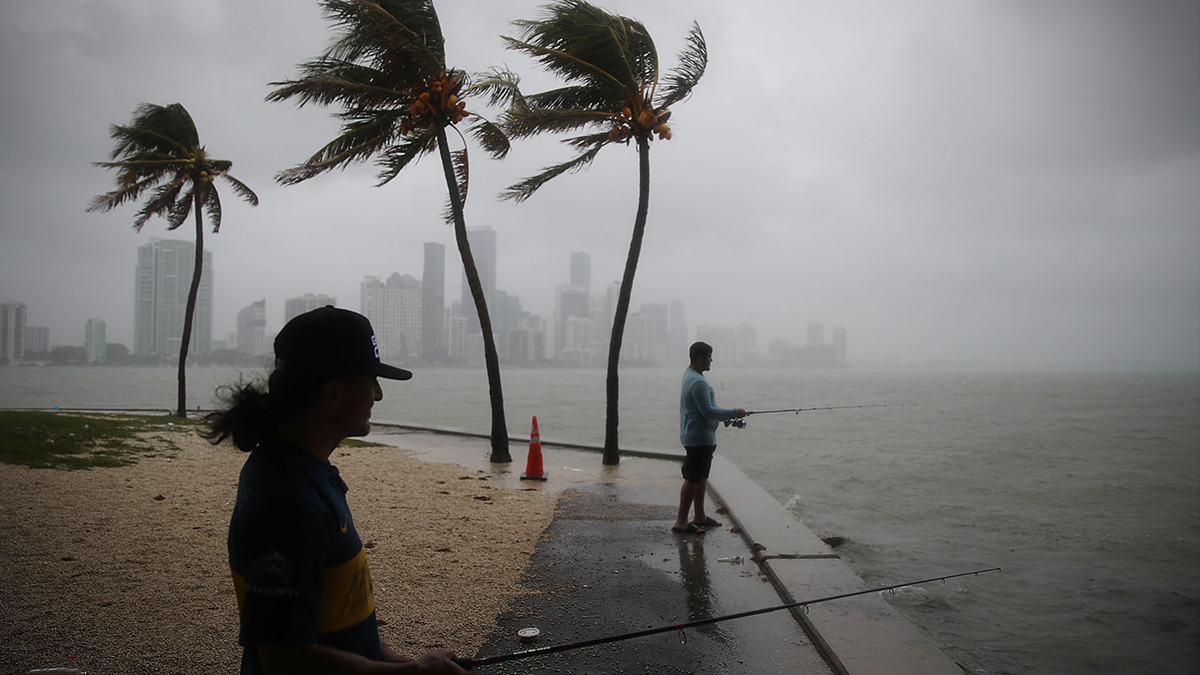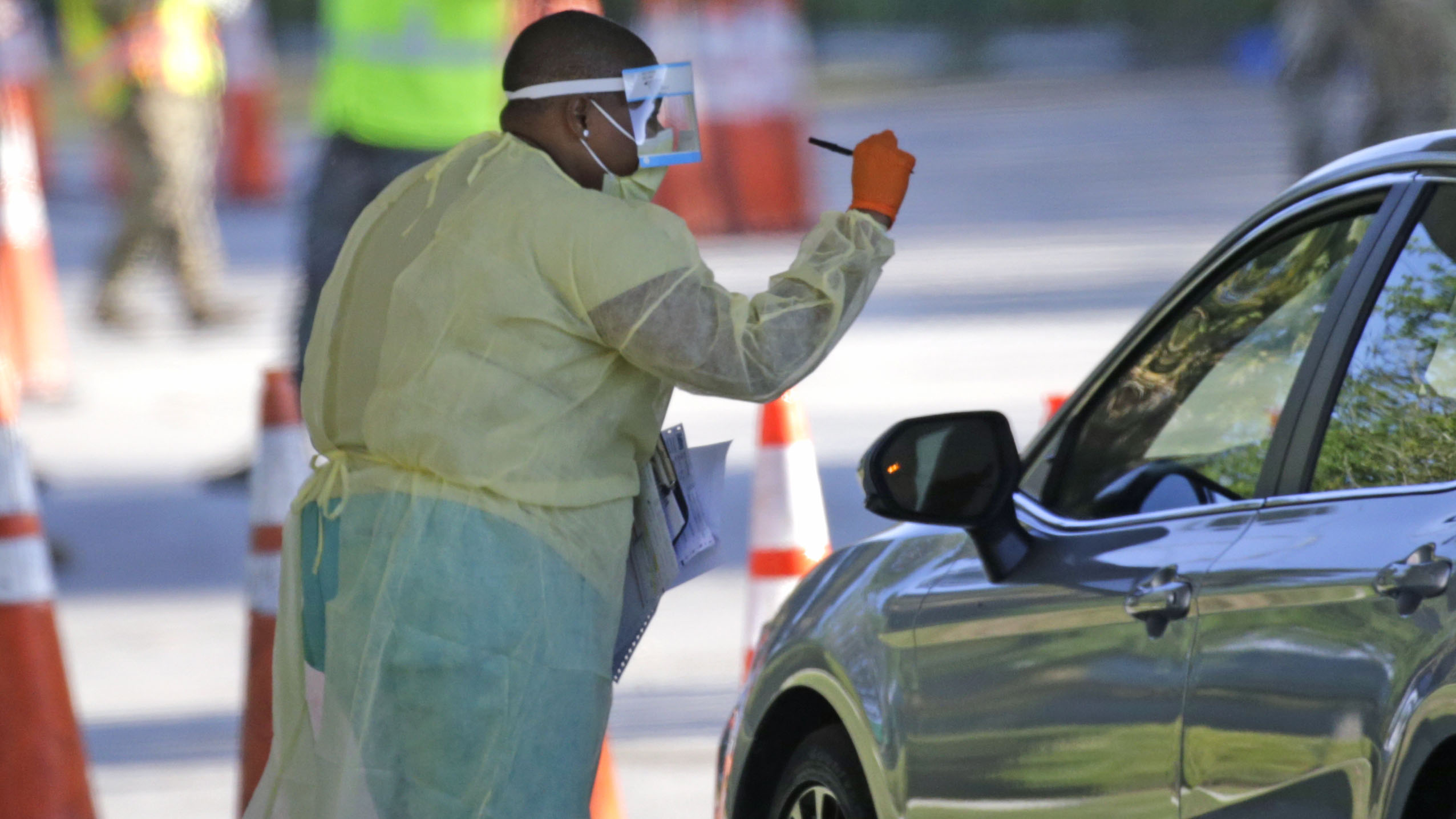A Hurricane and Storm Surge Watch is in effect for South Florida and the Florida Keys, as Tropical Storm Eta continued its path toward the region Saturday afternoon, moving towards the coast of central Cuba, according to the National Hurricane Center's 10 p.m. update.
Tropical Storm Eta is centered 140 miles (220 kilometers) west-southwest of Camaguey, Cuba, and is heading toward the northeast at 143mph (20 km/h) with maximum sustained winds of 65 mph (100 kph).
The center of Eta is expected to cross central Cuba Saturday night, approaching South Florida and the Florida Keys throughout Sunday before passing Monday.
A Hurricane Watch is in effect for Florida's coast, from Deerfield Beach to Bonita Beach, and the Florida Keys from Ocean Reef to the Dry Tortugas, including Florida Bay. A Storm Surge Watch is also in effect for Florida's coast, from Golden Beach to Bonita Beach, including Biscayne Bay, and the Florida Keys, from Ocean Reef to the Dry Tortugas, including Florida Bay.
Eta is expected to bring storm surge between 2 to 4 feet and 6 to 12 inches of rain across South Florida, including the Keys.
WEATHER
South Florida is bracing itself for the potential impacts of Eta.
On Friday, Miami-Dade County Mayor Carlos Gimenez declared a state of emergency, noting taht the county would be opening its evacuation center at 2 p.m. Saturday at the fairgrounds located at 10901 Coral Way, Gate 2 for residents who may need refuge.
"All residents should secure objects that winds could blow around, such as garbage carts, patio furniture, garden tools and toys," the mayor's office said in a press release.
The city of Hialeah Gardens will be distributing sand bags to residents Sunday at 13601 Northwest 107 Avenue. All residents will be allowed up to five bags per vehicle. If you need further information please contact Mayor Yioset De La Cruz at 305-558-4144, ydelacruz@cityofhialeahgardens.com.
The City of Opa-locka will also distribute sandbags to city residents between 9 a.m. and 3 p.m. on Saturday, while supplies last. The distribution will take place at the Public Works and Utilities Department located at 12950 Northwest 42nd Avenue.
In Lauderhill, free sand for residents who want to assemble sand bags is now available at Veterans Park in the northeast corner of the parking lot, located at 7600 Northwest 50th Street. Veterans Park will be opened Saturday until 6:00 p.m., and Sunday’s hours are 9:00 a.m. through 6 p.m. People are asked to bring their own bags and proof of Lauderhill residency. The sand is available on a first come, first self-serve basis.
The South Florida Water Management District said they are lowering canals and staffing pump stations and control rooms as they watch the forecast. They advised residents to secure any loose items that could clog storm drains or swales.
Miami-Dade Fire Rescue also was reminding residents of safety precautions they can take.
"If you see standing water, whether it’s driving or walking or biking, it is never a good idea to walk or drive into flooded areas as water may be deeper than it appears hiding all kinds of hazards like debris or sharp objects," Fire Rescue spokesperson Erika Benitez said.
Stay up to date with NBC 6 First Alert Weather and South Florida's most powerful radar First Alert Doppler 6000 by downloading the NBC 6 app for iOS or Android.
Back in Central America, searchers in Guatemala dug through mud and debris looking for an estimated 100 people believed buried by a massive, rain-fueled landslide, as the remnants of Hurricane Eta strengthened early Saturday as the storm churned toward Cuba.
Eta reached the region as a Category 4 hurricane Tuesday before weakening into a tropical depression. Authorities from Panama to Mexico were still surveying the damages from flooding and landslides following days of torrential rains; the confirmed death toll was in the dozens and expected to rise.
On Friday, search teams in Guatemalan pulled the first bodies from a landslide in San Cristobal Verapaz, but the work was slow and help was trickling in. Teams first had to overcome multiple landslides and deep mud just to reach the site where officials have estimated some 150 homes were devastated.
In neighboring Honduras, 68-year-old María Elena Mejía Guadron died when the brown waters of the Chamelecon river poured into San Pedro Sula’s Planeta neighborhood before dawn Thursday.
Mirian Esperanza Nájera Mejía had fled her home in the dark with her two children and Mejía, her mother. But while she held tight to her children, the current swept away Mejía.
Nájera continued searching desperately for her mother Friday morning. But Mejía’s body was recovered later and taken to the morgue where her relatives identified her.
“When the flooding started, the whole family was leaving the house,” said family friend Nery Solis. “Mirian had her two children and suddenly the current grabbed them and she wasn’t able to get her mom.”
The family transported Mejía’s body to the western city of Copan Friday. Her burial was scheduled for Saturday.
In southern Mexico, across the border from Guatemala, 19 people died as heavy rains attributed to Eta caused mudslides and swelled streams and rivers, according to Chiapas state civil defense official Elías Morales Rodríguez.
The worst incident in Mexico occurred in the mountain township of Chenalho, where 10 people were swept away by a rain-swollen stream; their bodies were later found downstream. Mexico's National Meteorological Service said Eta's “broad circulation is causing intense to torrential rains on the Yucatan peninsula and in southeastern Mexico.”
But the massive slide in Guatemala's central mountains threatened to double Central America's reported death toll in one remote community.
Late Friday, army spokesman Rubén Tellez said soldiers and community members had recovered the first three bodies. Hundreds of tons of mud, rock and debris entombed others.
Rescue teams struggled for hours Friday to reach the site from two different approaches. Smaller landslides blocked highways and decimated the dirt road leading to the community of Queja at the base of the slide. The indigenous community of about 1,200 residents consisted of simple homes of wood and tin roofs clinging to the mountainside.
Hurricane Eta’s arrival in northeast Nicaragua followed days of drenching rain as it crawled toward shore. Its slow, meandering path north through Honduras pushed rivers over their banks and pouring into neighborhoods where families were forced onto rooftops to wait for rescue.
The Honduran government estimates more than 1.6 million have been affected. It said rescues were happening Friday in San Pedro Sula and La Lima, but the need was great and resources limited.
The U.S. State Department said in a statement Friday that four U.S. helicopters from the Soto Cano Air Base near Tegucigalpa had flown to San Pedro Sula to participate in rescue operations. U.S. helicopters were also assisting in Panama where authorities confirmed five deaths in the western province of Chiriqui, which borders Costa Rica.



